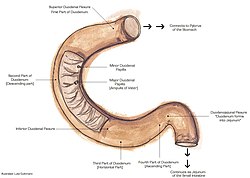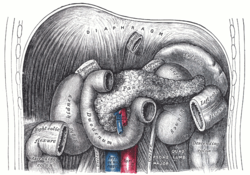| Suspensory muscle of duodenum | |
|---|---|
 The duodenum. The suspensory muscle of the duodenum attaches to the duodenojejunal flexure, shown. | |
 The duodenum and jejunum depicted in situ. The suspensory muscle of the duodenum connects posteriorly to the duodenojejunal flexure, behind the pancreas, shown. | |
| Details | |
| System | Gastrointestinal |
| Origin | Connective tissue surrounding coeliac artery and superior mesenteric artery |
| Insertion | Third and fourth-parts of duodenum, duodenojejunal flexure |
| Nerve | Coeliac plexus, Superior mesenteric plexus |
| Actions | Facilitates movement of food; embryological role in fixating jejunum during gut rotation |
| Identifiers | |
| Latin | musculus suspensorius duodeni, ligamentum suspensorium duodeni |
| TA98 | A05.6.02.011 |
| TA2 | 3781 |
| FMA | 20509 |
| Anatomical terms of muscle | |
The suspensory muscle of duodenum (also known as suspensory ligament of duodenum, Treitz's muscle or ligament of Treitz[1]) is a thin muscle connecting the junction between the duodenum and jejunum (the small intestine's first and second parts, respectively), as well as the duodenojejunal flexure to connective tissue surrounding the superior mesenteric and coeliac arteries. The suspensory muscle most often connects to both the third and fourth parts of the duodenum, as well as the duodenojejunal flexure, although the attachment is quite variable.
The suspensory muscle marks the formal division between the duodenum and the jejunum. This division is used to mark the difference between the upper and lower gastrointestinal tracts, which is relevant in clinical medicine as it may determine the source of gastrointestinal bleeding.
The suspensory muscle is derived from mesoderm and plays a role in the embryological rotation of the gut, by offering a point of fixation for the rotating gut. It is also thought to help digestion by widening the angle of the duodenojejunal flexure. Superior mesenteric artery syndrome is a rare abnormality caused by a congenitally short suspensory muscle.